ShodhKosh: Journal of Visual and Performing ArtsISSN (Online): 2582-7472
|
|
FUSION OF MODERN INTERIOR STYLE AND NORTH INDIAN TRADITIONAL INTERIOR STYLE
Manshi Sharma 1 ![]()
![]() ,
Manika Goel 2
,
Manika Goel 2![]()
![]() , Deepashree
Choudhary 3
, Deepashree
Choudhary 3![]()
![]()
1 2nd
Year Interior Design Student, KR Mangalam University, Gurugram, Haryana, India
2 Assistant
Professor, KR Mangalam University, Gurugram, Haryana, India
3 Professor,
Piloo Mody College of Architecture, Cuttack, Odisha, India
|
|
ABSTRACT |
||
|
The interior
design style of different states of India has been the subject of considerable
research in disciplines such as art forms, handicrafts and cultural
identities of interior styles. But modernization of the world has created a
rage of creating minimalistic spaces, this caused the need for the fusion of
traditional into modern interior style. This helped in retaining our culture
and preserving the traditional practices as well as artworks. The research
elaborated different ways to fuse elements like space, texture and colour
from North Indian traditional into Modern interior style. The fusion is
supported with the help of six case studies of houses with fused interior
design style from North Indian states. The paper concludes with the
identification of different ways in which designers and homemakers can fuse
traditional into modern interior styles. |
|||
|
Received 29 August 2023 Accepted 09 December 2023 Published 14 December 2023 Corresponding Author Manshi
Sharma, sharmamanshi0705@gmail.com DOI 10.29121/shodhkosh.v4.i2
ECVPAMIAP.2023.729 Funding: This research
received no specific grant from any funding agency in the public, commercial,
or not-for-profit sectors. Copyright: © 2023 The
Author(s). This work is licensed under a Creative Commons
Attribution 4.0 International License. With the
license CC-BY, authors retain the copyright, allowing anyone to download,
reuse, re-print, modify, distribute, and/or copy their contribution. The work
must be properly attributed to its author.
|
|||
|
Keywords: Modern Interior Style, Modernization,
Sustainability, Traditional Interior Style, Vernacular |
|||
1. INTRODUCTION
The world nowadays is changing which is impacting every aspect of people’s lives. Interior design is no exception as it is influenced by many different elements of civilization development. The blending of modern and traditional interior design styles has become a popular trend in the design industry. Research papers were explored covering Modern interior style, traditional interior style of different states of north India like Haryana, Uttarakhand and Himachal Pradesh and artworks and handicrafts found in these states. This fusion allows us to sustain traditional elements while incorporating modern touches through this unique and personalized are formed which fulfils the requirement of modernisation and conserve our culture and traditions. Space, colour, and texture are basic elements of design, hence exploring these parameters for the fusion of both interior styles. They play a crucial role in creating a cohesive and harmonious space that which are visually appealing and offers functionality. Spaces in design refers to the area around, between, and within elements of a design Pattacini (2021). On the other hand, texture and colour are the visual and tactile quality of any object. The choice of colours, textures, and spatial arrangements influence human’s mood and emotions Jalil et al. (2012), while reflect in cultural traditions and values. Integration of modern and traditional design elements into these key aspects of interior design. This is followed by creation of a unique and personalized space which reflected both modern design trends and cultural heritage.
With time our traditional art forms, handicrafts, furniture and interior styles lost their importance in the world of design and got vanished from the interior spaces. On the other hand, since 1950s, a rise in modernisation was observed where people started emerging with a taste of basic, simplistic and minimalistic living space. Modern Interior Style became the epitome of “less is more” Rashid & Ara (2015), a bold statement quoted by Ar. Ludwig Mies van der Rohe in 1947. Facades and spaces became more peaceful and simpler with less decorations and more impressionism through abstraction. Structural elements were made visible to the viewer and subtleness added to the taste Sandeva & Despot (2016).
Where Louis Sullivan publicly declared that "form
follows function", and it became the core principle for design Sandeva & Despot (2016), contrary to it our vernacular interior style of Northern
India which refers to the design style including local needs and construction
representing their culture and traditions, was full of artworks, handicrafts
and creativity Lewis (2019).
Front of the façade was the main concern where large number of openings were
provided for ventilation. Spaces were separated according to their
functionality and local art works and paintings were seen creating a peaceful
ambience creativity.
This paper aims to highlight different ways of fusion of traditional interior style into modern interior style. The objective of this paper to review the role of three element of design offering inspiration to designers and homeowners. Also, to identify usage of space, colour and texture in interior spaces and lastly analyse the fusion of these elements by preserving traditional elements and integrating modern design elements and while maintaining cultural heritage.
2. Methodology
Research paper were analysed with the help of Keywords - “Modern Interior Style, Modernization, Sustainability, Traditional Interior style, Vernacular” were gathered through online research on “Academia, ScienceDirect, Mendeley, Google Scholar and Research Gate”. The paper focused on northern zones of India which became its limitation. But to have better understanding on different aspects like modernism, spaces, colours, textures, traditional style. Knowledge was gathered on specific topics through the analysis, authors knowledge the research papers discussing the fusion of both styles are not significant. In continuation with that case studies were chosen (six case studies) two each from three different states. They were shortlisted on the basis of façade being constructed according to modern architecture and interior consisting of traditional elements as décor items. The paper reviewed for the formation of this manuscripts were mostly review papers focused on the above aspects. This review paper was based on primary and secondary sources.
Figure 1

|
Figure 1 Pareto Table of the Number of Papers on Parameters for the Research Source Author |
Figure 1 Explains that research papers on elements
of design like space, colour, texture, light, etc. and other elements like
handicrafts, artforms, spatial planning, sustainability etc. were found.
Researches were also done in the field of Vernacular Interior Style and Modern
Interior Style but a very few research papers were found on the fusion of both
the Vernacular and the Modern Interior style. Table 1 depicts the number of papers collected and
the parameters briefly studied from them to complete the research paper.
Table
1
|
Table 1 Research Papers Read on the Following Parameters |
|||
|
Paper Title |
Parameter |
||
|
1 |
Birch (2007) |
Public and Private Space in Urban Areas: House,
Neighbourhood, and City |
Space, Modern Interior Style |
|
2 |
Bosia et al. (2015) |
Sheep wool for sustainable architecture |
Sustainability |
|
3 |
Creanga et al.
(2010) |
Vernacular architecture as a model for
contemporary design |
Fusion of Modern and Vernacular Interior Style |
|
4 |
Dantas et al.
(2022) |
The psychological dimension of colours: a systematic literature review on
colour psychology |
Colour |
|
5 |
Elliot (2015) |
Colour and psychological
functioning: A review of theoretical and empirical work |
Colour |
|
6 |
Ellio &
Maier (2014) |
Colour Psychology: Effects of Perceiving Colour on Psychological
Functioning in Humans |
Colour |
|
7 |
Fedorovskaya et al. (2021) |
Decor as a Way to Form a Style in a Modern
Interior |
Modern Architecture, Artform, Handicrafts |
|
8 |
Hazaea et al. (2022) |
Sustainability assurance practices: a systematic review and future
research agenda |
Sustainability |
|
9 |
Jalil et al.
(2012) |
Environmental colour impact upon human behaviour:
A review |
Colour |
|
10 |
Kaushik &
Gupta (2017) |
Aipan creative art of
Kumaon |
Artforms, Vernacular Interior Style |
|
11 |
Lekshmi et al.
(2017) |
An investigation on the potential of mud as
sustainable building material in the context of Kerala |
Texture, Sustainability |
|
12 |
Lewis (2019) |
Composite Vernacular Constructions |
Vernacular Interior Style |
|
13 |
Negi et al.
(2017) |
Architecture of Uttarakhand and Construction
Techniques for Affordable Housing |
Vernacular Interior Style, Colour |
|
14 |
Nikolic & Vasilski (2017) |
Minimalism in contemporary architecture as one of the most usable
aesthetically-functional patterns |
Modern Interior Style |
|
15 |
Ojha &
Sharma, (2017) |
Transition from Vernacular to Modern
Architecture: Gurgaon, India |
Fusion of Modern and Vernacular Interior Style |
|
16 |
Pattacini (2021) |
Defining public open spaces: an investigation framework to inform
planning and design decision-4making processes |
Space, Spatial Planning |
|
17 |
Pellegrino
& Jeanneret (2009) |
Meaning of space and architecture of place |
Space |
|
18 |
Rashdan &
Mhatre (2022) |
The Influence of Vernacular Sustainability on Contemporary Interior
Design |
Sustainability |
|
19 |
Rashid &
Ara (2015) |
Modernity in tradition: Reflections on building
design and technology in the Asian vernacular |
Fusion of Modern and Vernacular Interior Style |
|
20 |
Sandeva & Despot (2016) |
The modern style in interior and exterior design |
Modern Interior Style |
|
21 |
Saraswat &
Mayuresh (2017) |
Koti Banal Architecture of Uttarakhand:
Indigenous Realities and Community Involvement |
Vernacular Interior Style |
|
22 |
Savavibool (2020) |
Effects of colour schemes on aesthetic response of the work environment |
Colour, Sustainability |
|
23 |
Sharma &
Sharma (2013) |
Traditional and vernacular
buildings are ecological sensitive, climate responsive designs- Study of
Himachal Pradesh |
Vernacular Interior Style |
|
24 |
Shayan &
Xu (2004) |
Value-added utilisation of waste glass in
concrete, Cement and Concrete |
Texture, Sustainability |
|
25 |
Shorewala & Ardito (2021) |
The Psychological Impact of Colour and Light in
Interior Design on Teenagers |
Modern Interior Style, Colour |
|
26 |
Suhamad & Martana (2020) |
Sustainable Building Materials |
Sustainability, Texture |
|
27 |
Thakkar &
Morrison (2010) |
Wood and Stone: The vernacular architecture of
Himachal Pradesh |
Vernacular Interior Style, Texture |
|
28 |
Vigaray (2003) |
Visual merchandising and the creation of discernible retail brands |
|
|
29 |
Weingerl & Javorsek (2018) |
Theory of colour harmony and its application |
Colour |
|
Source Author |
|||
3. Result and Discussion
Fusion of both the Modern and Traditional Interior style can be done by using elements of design- Space, Colour and Texture.
3.1. Space
Difference between spaces in Modern interior style and Traditional interior style is discussed.
3.1.1. Modern
Figure 2

|
Figure 2 Space Designed in Modern Interior Style Source Author |
In modern style minimalistic approach is adopted for the creation of the space. Visible work and nature of the project is chosen over concealing the nature of the spaces are created through beams, shapes, windows, staircases, fireplaces, roof lines and other structural elements. Straight and angled are preferred than curved organic line. In modern style functionality plays a vital role and become of designing any space Sandeva & Despot (2016). All the necessary décor elements were removed as used in traditional style Nikolic & Vasilski (2017). Along with that simplicity was another element and less focus given to the symmetry. Figure 2 depicts space, where television cabinet and sofa are placed in a closed space of a room. Space left bare is used for circulation. Hence, spaces can be found everywhere around us and plays a vital role as an element of design.
3.1.2. Traditional
Spaces in traditional style are divided into three
categories: public, semi-public and private Birch
(2007). Public spaces such as veranda and drawing
room are meant for visitors to rest and public gatherings. Semi-private space
such as central courtyard are grouped for cooking, eating and entertaining
female guests. Private spaces such as bedrooms and niches that are used for
sleeping and for storage respectively Ojha
& Sharma (2017). Spaces are created in
a manner to provide appropriate insulation from solar radiation and regulation
of day light and ventilation inside the building Sharma & Sharma (2013).
This reduces dependency on technology Rashdan
& Mhatre (2022). Spaces in vernacular
houses are vertically smaller at colder regions of the north Indian states,
this helps to retain the heat provide cooling effect local materials are used
in these spaces like stones, deodar wood, other types of timber, sun dried bricks,
mud and sand Thakkar
& Morrison (2010).
3.2. Colour
Use of colour in Modern and Traditional interior style is elaborated.
3.2.1. Modern
Colour schemes used in modern style are mainly
monochromatic with some accent. This scheme develops an ambience by creating a
focus Weingerl & Javorsek (2018). Shades and tints of
blue, grey, orange, neon green, olive green was mostly visible in this style Sandeva & Despot (2016). Human psychology is
influenced by colour used in any space Dantas
et al. (2022), Shorewala & Ardito (2021).
Blues signifies intellectuality, trust, efficiency, duty, logic, unfriendliness
and others Elliot & Maier (2014), Vigaray (2003). Also, it creates
calmness and relaxation effect on mind Elliot & Maier (2014). Green, on the other
hand, is a relaxing colour, helping to reduce stress levels and create a
calming effect Jalil
et al. (2012). Red emphasises on
physical courage, strength, warmth, energy, aggression and strain Elliot (2015).
3.2.2. Traditional
Colours plays key role in the aesthetics of traditional
houses where walls are for painted white, cream, yellow, light blue and others Savavibool (2020). Doors and windows are
coated with green, blue, brown and skirting red is used. Walls are generally in
brown shade as they are plastered with ‘phuska’ mud
or they are painted in white colour for creating a neutral shade. In roofs
generally slates or timbers are used which are predominantly in the shade of
brown Negi
et al. (2017). Therefore, mostly
brown shades highlighted in traditional house for their flooring and roofing.
Wood and mud are used for flooring material which forms the shades of brown Thakkar
& Morrison (2010). Figure 3 shows the
blue-coloured doors and a dark brown coloured slate roof used in an example of
a house in Uttarakhand.
Figure 3

|
Figure 3 Vernacular Styled House in Uttarakhand Negi et al. (2017). |
3.3. Texture
Different ways in which texture can be created in both the interior style is mentioned below.
3.3.1. Modern
Modernization has created movement of vision with help of
texture usage in interior spaces Pellegrino & Jeanneret
(2009).
Different materials are used to create different textures for designing a
living space. Timber as a material is being used for giving traditional and
vernacular touch. Glasses are used for clear, minimalist approach. Apart from
that plastics, stainless steel and other reusable industrial wastes were
applied in spaces Sandeva & Despot (2016). Also, the space has
exposed finishes like exposed brick, exposed ducts pipes which create the
texture of naturalness. Velvet, cotton, linen fabricated, marble or polished
wood furniture are utilized in space to formulate the texture. Apart from these
textures are added through painting and sculptures. Figure 4 represents exposed
beam uses of glass in façade and polished wooden furniture leading to
minimalistic approach.
Figure 4
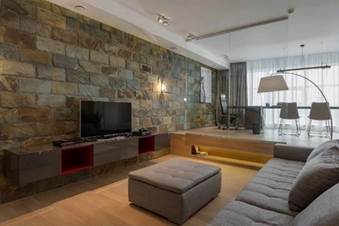
|
Figure 4 Materials Used in Modern Interior Style Fedorovskaya et al. (2021). |
3.3.2. Traditional
Traditional paintings and sculptors created textures. The style also had pottery which uses colourful shapes forming geometrical and organic motifs. Textures are also created by using turmeric, geru and rice paste during festivals to develop paintings of gods and goddesses Kaushik & Gupta (2017). Materials also played a role in creating textures for the space. Walls are made of stone along with that timber for structural purposes and slates for roofing Creanga et al. (2010). Clay and cow dung is used as coating over walls insulation and plastering Saraswat & Mayuresh (2017). These materials create organic and rough textures to the space. Furniture, rugs and wood carving also add up in formulating traditional interior style Thakkar & Morrison (2010). Aipan art, a repeated pattern of organic motifs was made by rice flour and lime water over geru to create visual textures on the walls. Figure 5 depicts the use of aipan art on a vernacular house floor.
Figure 5
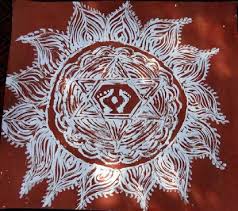
|
Figure 5 Aipan Art on the floor of Uttarakhand House Kaushik & Gupta (2017). |
3.4. Survey
A survey was conducted in order to categorize elements of design into modern and traditional interior style. Parameters are defined as per experts by asking the following questions-
Figure 6

|
Figure 6 94.7% Experts Voted for Monochromatic Colour
Schemes to be a Modern Interior Style Element Source Author |
Figure 7

|
Figure 7 50% Experts Voted for
Colours Like Brown, Beige, Off-White, etc. to be a Modern Choice and the
Other Half Opposed the Statement Source Author |
Figure 8
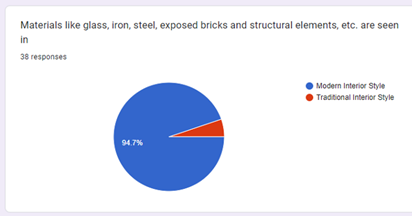
|
Figure 8 94.7% Experts Voted for Materials Like Glass, Iron, Steel, Exposed Bricks, etc. to be a Modern Interior Style Element Source Author |
Figure 9

|
Figure 9 89.5% Experts Voted for
Materials Like Timber, Stone, Mud, Clay, Thatch, etc. to be Traditional
Interior Style Element Source Author |
Figure 10

|
Figure 10 81.6%
Experts Voted for Jaali Work, Floor and Wall Paintings, Woolen Durrie (Rug), etc. to be a Traditional Interior Style Element Source Author |
Figure 11
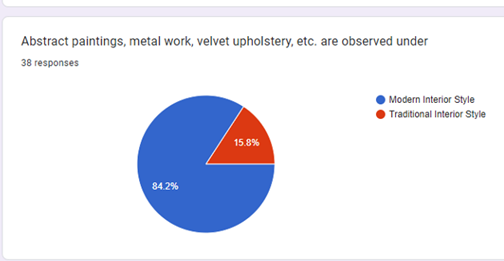
|
Figure 11 84.2% Experts Voted for
Abstract Paintings, Metal Work, Velvet Upholstery, etc. to be a Modern
Interior Style Element Source Author |
The Figure 6, Figure 7, Figure 8, Figure 9, Figure 10 and Figure 11 depicts the result of the survey performed between design professionals, design students and researchers to categorise elements of design into modern or traditional interior style.
3.5. Case studies
The six case studies of different states of northern zone were explored for better understanding of fusion of modern and tradition interior styles.
3.5.1. Case study 1- Residence 568,
Panchkula, Haryana
Residence 568, the project is located in Panchkula (Haryana), which is designed by Aman Aggarwal. The site is located on one of the internal sector roads of Panchkula. The concept of the project tried to create a balance between private and public spaces. Arrangement of spaces while overlooking the public space and offering interaction with environment was aim of the project. Central courtyard and waterbody with terrace garden on the second floor created a cooling effect. Colours like white, brown, beige and grey are used. Texture is developed through materials like wood veneers and glasses which are applied in the interiors. Traditional styled furniture is used. Major surface area is covered with wooden texture to bring nature inside the façade. Figure 12 and Figure 13 shows the fusion of modern and traditional interior style created by earthy colours like brown and beige with materials like glass and timber used in the facade (Source: Author)
Figure 12

|
Figure 12 Texture is Created
Through Glasses to Create Modern Effect Source Author |
Figure 13
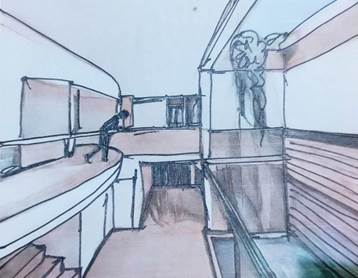
|
Figure 13 Central Courtyard is
Created to Put a Vernacular Element into the Facade Source Author |
3.5.2. Case study 2- Villa in the woods, Uttarakhand
The house was designed by Studio Lotus founded by Ritika Rakhiani. Project was headed by Ambrish Arora, Sidhartha
Talwar, Ansel Colaco, Satish Kumar, Adil Hussain, Ayesha Hussain, Priya Jindal
as team members. Villa in the woods lies
between Bhimtal and Mukteshwar.
Which is 17.7 km away from Bhimtal. The home is of
three floors and designed to evoke the experience of treehouse-living. It is
characterized by the blue roof with sky scrapers for giving access to sunlight
for thermal balance at high altitude. Large windows are used for minimalistic
approach. Wooden flooring and ceiling are used for texture. Uttarakhand dan and
local patterns for upholstery are used in interiors for warmth and traditional
touch respectively. Material like timber, slate and local stone are used to
develop traditional style in the modern facade. A monochromatic colour theme is
used for modern touch whereas choice of colours is inspired by the traditional
colours. Figure 14 explains an insight of
the interior design of the house (Source: Author).
Figure 14

|
Figure 14 Wooden Texture Used in the
Ceiling Source Author |
3.5.3. Case study 3-The Hill House, Himachal Pradesh
The hill house, Himachal Pradesh is located approximately
10 km away from Shimla. The project Hill House is located on the peripheral
roads of residential area, The house was designed by Urban Mistrii
studio founded by Ritika Rakhiani. He projects team
included Ritika Rakhiani, Manisha Aggarwal, Sujit
Chaudhary. The theme of house is related to neo-gothic architecture with hints
of modernity. The spaces are designed over looking to the front area of the
site. The texture is formed through exposed beams and wooden artworks. Traditional
chest drawers are seen complimenting the modern living area furniture. Metal
ornaments are used such as bronze for traditional look whereas upholstery on
sofa and dining chairs of velvet followed modern style. Traditional styled
wooden furniture is seen in the bedroom where as the upholstery used is
minimalist. Arched doors are seen fusion is created through traditional doors. Figure 15 and Figure 16 shows the modern plain
texture created on the walls emphasized by textures created by flooring and
traditional mirror art pieces (Source: Author).
Figure
15
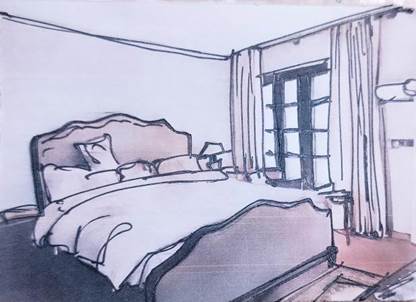
|
Figure 15 Texture Created by
Plain White Wall and Brown Flooring Source Author |
Figure 16

|
Figure 16 Traditional Mirror
Artwork on the Walls of Modern House Source Author |
3.5.4. Case study 4-In the Mountains, Uttarakhand
In the mountains is a project designed by Ant Studio in 2019 which is located in Mukteshwar, Uttarakhand. The project is extended in the area of 2 acres. The architect is Monish Siripurapu. The project tried to bring together art, nature and technology. Spaces were categorised in public, semi public and private spaces in which entrance lobby, semi open terrace, glass-ensconced conservatories, living and dining space and bedrooms are included. Colours are inspired by the nature and traditional interior style. Blue, white, beige and brown colour are majorly used in the façade. Textures are created with locally found materials like toona wood for the red-toned floorboards, dark stone textures for the bar and fireplace and teak stone cladding for the façade. For more textures traditional wooden and modern leather upholstered furniture is used which is accentuated by traditional sculptors and modern paintings. Figure 17 and Figure 18 the living area furnished with a combination of modern and traditional styled furniture and façade covered with nature inspired colours respectively (Source: Author).
Figure 17

|
Figure 17 Wooden Furniture and
Leather Upholstered Furniture in the Living Room Source Author |
Figure 18
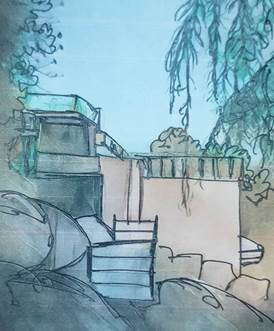
|
Figure 18 Nature and
Traditional Style Inspired Colours Used on the Facade Source Author |
3.5.5. Case study 5- House under shadows, Haryana
House Under Shadows is
located outside Karnal, Haryana. It is a palatial house which has created its
own mini ecosystem. It is designed by Zero-Energy Design Lab founded by Sachin
Rastogi and Payal Seth Rastogi. The project categorizes space into public,
semi-public and private spaces where courtyard, swimming pool, dining area and
bedrooms are the main components. A canopy is created over the house for
filtering the sunlight and giving the project a vernacular touch. Textures are
created by wooden ceilings made up of locally found renewable wood species and
entrance cladded in a dark, leather-textured Gwalior mint
stone. A combination of modern furniture in living area and traditional
furniture in courtyard is also used to create texture. Vernacular ‘jaali’ work is also implied in the interiors for creating
partition between spaces. Traditional themes of colours are chosen like white,
beige and brown. Figure 19 shows the living area with modern furniture and ‘jaali’
partition (Source: Author).
Figure 19

|
Figure 19 Jaali
Work Used to Give a Traditional Touch to the Modern Façade Source Author |
3.5.6. Case study 6- Our Place Himalayas, Himachal Pradesh
Our Place Himalayas is located in Kullu, Himachal Pradesh which is owned by Anita Khullar. The project consist of sloping roof with stone walls at the exterior. Spaces include terrace, courtyard, dining, living, modular kitchen and bedroom. Choice of colour is inspired by traditional interior style as off-white, green and earthy brown colour are used. Textures are created with modern furniture and upholstery with traditional prints. Locally available rugs and vernacular style doors and windows are put for giving traditional textures to the modern façade. Figure 20 and Figure 21 depicts Our place himalayas, a facade with sloping roof, off-white and earthy brown colour used in the interior of the façade and combination of modern furniture and traditional printed upholstery for creating textures respectively (Source: Author).
Figure 20
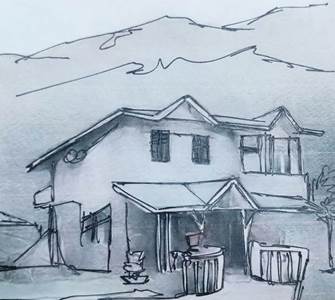
|
Figure 20 Our Place Himalayas, Kullu , Himachal Pradesh Source Author |
Figure 21
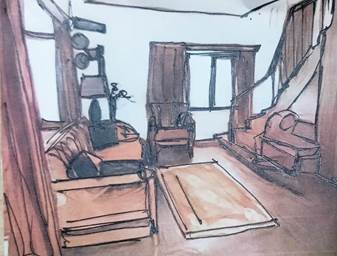
|
Figure 21 Traditional Prints Used on the Rugs and Upholstery of
Modern Furniture Source Author |
Table 2
|
Table 2 Comparision of all the Elements of Each State Discussed Above on the Basis of the Case Studies |
||||
|
S. No |
Case Study |
Elements of Traditional Interior Style for Respective States. |
Elements of Modern Interior Style |
Remarks |
|
1 |
Case Study 1- Residence 568, Panchkula, Haryana |
Space- Central courtyard Colour- brown Texture- wood, furniture, metal ornaments |
Space- Waterbody and terrace garden Colour- white, beige, grey Texture- wood veneers, glass, furniture, modern sculptors,
hanging plants |
A minimalist space was created with a slight touch of traditional
elements. Courtyard was designed with modern waterbody with the use of glass.
Traditional styled furniture was used with plain accent walls and modern
sculptors. |
|
2 |
Case Study 2- Villa in
the woods, Uttarakhand |
Space- tree house
inspired space, sloping roof Colour-blue, brown Texture- rugs,
furniture, upholstery, wooden ceiling |
Space- dining cum
living area, glass ensconced
conservatories Colour- off-white Texture- wooden
flooring, living furniture, plain walls |
A vernacular style
façade was built in a modern way with glass and sky scrapers by giving it
traditional roots with rugs, patterns, colours etc. |
|
3 |
Case Study 3- The Hill House, Himachal Pradesh |
Space- neo-gothic architectural styled space Colour- brown Texture-wooden carvings, mirror work, arched
doors, wooden furniture, metal ornaments. |
Space- exposed beams, dining area Colour- white Texture-velvet upholstery, white dining upholstery,
plain walls |
A modern façade was decorated with traditional doors, windows and
furniture where a plain minimalistic wall was accentuated by traditional
mirror artworks to create emphasis. |
|
4 |
Case Study 4- In the
Mountains, Uttarakhand |
Space- entrance
lobby, bedrooms Colour- blue, brown Texture-toona
wood, teak stone cladding, traditional wooden furniture, sculptors |
Space- semi open
terrace, glass-ensconced
conservatories, living and dining space Colour- white, beige Texture- dark stone, leather
upholstered furniture, paintings |
A modern façade was
tried to build in an uneven terrain and furnished with modern and traditional
furniture, modern semi open terrace, traditional patterns, rugs and
upholstery. |
|
5 |
Case study 5- House under shadows,
Haryana |
Space- courtyard, bedroom, canopy roof Colour- brown Texture- wooden ceiling, jaali
work, courtyard furniture |
Space- swimming pool, dining area Colour- white, beige Texture- stone walls, living area furniture,
facade |
A modern furniture with a traditional canopy styled roof was created and
decorated with modern and traditional furniture, stone cladded walls, plain
walls, jaali work partitions and many more. |
|
6 |
Case Study 6- Our Place
Himalayas, Himachal Pradesh |
Space- Sloping roof, open courtyard, terrace,
bedroom Colour-Brown, beige, off-white Texture- traditional patterns, fabric,
rugs, upholstery, wooden furniture, stone walls |
Space- living, dining,
modular kitchen Colour- White, green Texture- Modern furniture, wall texture, glass,
curtains |
A vernacular look of
façade with modern techniques was created. Modern furniture was used with
traditional upholstery. Colours were used from modern and traditional taste.
Glass was used to create transparency and glossy texture. |
|
Source Author |
||||
Table 2 discusses about the vernacular elements of North Indian states like Haryana, Uttarakhand, Himachal Pradesh respectively and modern elements in the design and the way they are merged with each other to create a fusion of both the interior styles. Thus, it is evident from these three case studies that the fusion was done with the help of colour and texture.
The fusion of Modern interior style and Traditional North Indian interior style creates a positive impact on the environment. Vernacular colour themes generally include earthy colours which help in maintaining the thermal balance inside the facade. Adding local handicrafts in the design such as carpets, rugs and mats provides insulation on flooring in hilly areas and helps local vendors to conserve the art. Using Pottery and baskets as an element in the design reduces the use of non-biodegradable decorative items in the façade. Using modern furniture minimize the use of timber or other raw material as it is minimalistic in nature and requires less material to acquire its form. Thus, the idea of fusion becomes more effective.
Chasing Modernisation in Interior style has also paved ways to conserve the natural resources and maintain the environment in order to develop a better quality of life, known as Sustainability Hazaea et al. (2022). Glass, in the modern interior style, can be a sustainable option as it can be reused and recycled Shayan & Xu (2004). Also, it allows more sunlight to come inside the house, which can be beneficial for hilly areas. Whereas using mud, clay and stone for creating textures reduce pollution and environmental depletion Lekshmi et al. (2017). Woolen rugs, durrie, are biodegradable materials and hence, doesn’t affect environment negatively Bosia et al. (2015). Whereas, Traditional handicrafts like basket weaving, pottery, bamboo crafts, shell crafts, etc. are all sustainable choice for decorating the interiors and fusing them with the modern façade Suhamad & Martana (2020).
4. Conclusion
The above section elaborates fusion of modern and traditional interior style while retaining its cultural value. Colours and textures being the element of design, played vital role in creating the fusion. The image of decorative pieces, carpets as well as textures in flooring and wall helped to create the fusion of both styles. Materials like timber, concrete etc. were commonly used in both the styles. Authors suggest that textures created by clay, mud and stones can be used in exposed finishes to develop the traditional touch in modern style. On the basis of case studies mentioned above, following are some design tips to use for the fusion of both the styles-
1) Vernacular colour themes can be implied on modern façade.
2) Traditional practises and paintings can be opted for decorating walls.
3) Traditional art pieces like sculptors, vases, wall hangings etc. can be put in a modern house.
4) Local handicrafts like rugs, mats, carpets, baskets, pottery etc. can be used their functionality and aesthetics.
5) Modern furniture with traditional prints and colours also helps creating a fusion.
6) Exposed structural elements helps create a modern façade, etc.
7) However, the author recommends the explanation of the fusion of both the styles on spaces as an element of design.
CONFLICT OF INTERESTS
None.
ACKNOWLEDGMENTS
None.
REFERENCES
Birch, E. L. (2007). Public and Private Space in Urban Areas: House, Neighborhood, and City, in: Cnaan, R. A., Milofsky, C., Handbooks of Community Movements and Local Organizations, Springer, New York, USA, 118-128. https://doi.org/10.1007/978-0-387-32933-8_8.
Bosia, D., Savio, L., Thiebat, F., Patrucco, A., Fantucci, S., Piccablotto, G., & Marino, D. (2015). Sheep Wool for Sustainable Architecture. Energy Procedia, 78(11), 315-320. https://doi.org/10.1016/j.egypro.2015.11.650.
Creanga, E., Ciotoiu, I., Gheorghiu, D., & Nash, G. (2010). Vernacular Architecture as à Model for Contemporary Design. WIT Transactions on Ecology and the Environment, 128(3), 157-171. https://doi.org/10.2495/ARC100141.
Dantas, I. J. D. M., Batista, F. E. A., Solino, L. J. S., Freire, A. G., Nascimento, M. N. D., & Junior, G. S. (2022). The Psychological Dimension of Colours: A Systematic Literature Review on Colour Psychology. Research, Society and Development, 11(5), 1-22. https://doi.org/10.33448/rsd-v11i5.28027.
Elliot, J. A. (2015). Colour and Psychological Functioning: A Review of Theoretical and Empirical Work. Frontiers in Psychology, 6, 1-8. https://doi.org/10.3389/fpsyg.2015.00368.
Elliot, J. A., & Maier, M. A. (2014). Colour Psychology: Effects of Perceiving Colour on Psychological Functioning in Humans. Annual Review of Psychology, 65(1), 95-120. https://doi.org/10.1146/annurev-psych-010213-115035.
Fedorovskaya, N. A., Chernova, A. V., Kravchenko, I. A., & Petukhov, V. V. (2021). Decor as a Way to Form a Style in a Modern Interior. IOP Conference Series: Materials Science and Engineering, 1079(5), 1-7. https://doi.org/10.1088/1757-899X/1079/5/052041.
Hazaea, S. A., Zhu, J., Khatib, S. F. A., & Bazhair, A. H. (2022). Sustainability Assurance Practices: A Systematic Review and Future Research Agenda. Environmental Science and Pollution Research, 29(4), 4843-4864. https://doi.org/10.1007/s11356-021-17359-9.
Jalil, N. A., Yunus, R. M., & Said, N. S. (2012). Environmental Colour Impact Upon Human Behaviour: A Review. Procedia - Social and Behavioral Sciences, 35(5), 54-62. https://doi.org/10.1016/j.sbspro.2012.02.062.
Kaushik, A., & Gupta, M. (2017). Aipan Creative Art of Kumaon. International Journal of Home Science, 3(2), 640-642.
Lekshmi, M. S., Vishnudas, S., & Nair, D. G. (2017). An Investigation on the Potential of Mud a Sustainable Building Material in the Context of Kerala. International Journal of Energy Technology and Policy, 13(1/2), 107-122. https://doi.org/10.1504/IJETP.2017.080621.
Lewis, M. (2019). Composite Vernacular Constructions. Built Heritage, 3(4), 26-40. https://doi.org/10.1186/BF03545717.
Negi, S. K., Jain, H. K., & Singh, V. (2017). Architecture of Uttarakhand and Construction Techniques for Affordable Housing. Journal of Environmental Nanotechnology, 6(2), 30-35. https://doi.org/10.13074/jent.2017.06.172247.
Nikolic, M., & Vasilski, D. (2017). Minimalism in Contemporary Architecture as One of the Most Usable Aesthetically-Functional Patterns. Architecture and Civil Engineering, 15(3), 333-345. https://doi.org/10.2298/FUACE160814029N.
Ojha, S., & Sharma, A. K. (2017). Transition from Vernacular to Modern Architecture. International Journal on Emerging Technologies, 8(1), 408-415.
Pattacini, L. (2021). Defining Public Open Spaces: An Investigation Framework to Inform Planning and Design Decision-Making Processes. Landscape Research, 46(5), 653-672. https://doi.org/10.1080/01426397.2021.1881947.
Pellegrino, P., & Jeanneret, E. P. (2009). Meaning of Space and Architecture of Place. Semiotica, 175(9), 269-296. https://doi.org/10.1515/semi.2009.049.
Rashdan, W., & Mhatre, V. (2022). The Influence of Vernacular Sustainability on Contemporary Interior Design. International Journal of Visual Design, 16(2), 53-68. https://doi.org/10.18848/2325-1581/CGP/v16i02/53-68.
Rashid, M., & Ara, D. R. (2015). Modernity in Tradition: Reflections on Building Design and Technology in the Asian Vernacular. Frontiers of Architectural Research, 4(1), 46-55. https://doi.org/10.1016/j.foar.2014.11.001.
Sandeva, V., & Despot, K. (2016). The Modern Style in Interior and Exterior Design. Applied Researches in Technics, Technologies and Education, 4(1), 72-78. https://doi.org/10.15547/artte.2016.01.008.
Saraswat, S., & Mayuresh, G. (2017). Koti Banal Architecture of Uttarakhand: Indigenous Realities and Community Involvement, in: Chakrabarty, A., Chakrabarty, D., Smart Innovation, Systems and Technologies - Research into Design for Communities, Springer, New York, USA, 165-177. https://doi.org/10.1007/978-981-10-3521-0_14.
Savavibool, N. (2020). Effects of Colour Schemes on Aesthetic Response of the Work Environment. Kasetsart. Journal of Social Sciences, 41(3), 581-586. https://doi.org/10.34044/j.kjss.2020.41.3.20.
Sharma, S., & Sharma, P. (2013). Traditional and Vernacular Buildings are Ecological Sensitive, Climate Responsive Designs- Study of Himachal Pradesh. International Journal of Chemical, Environmental and Biological Sciences, 1(4), 605-609.
Shayan, A., & Xu, A. (2004). Value-Added Utilisation of Waste Glass in Concrete. Cement and Concrete Research, 34(1), 81-89. https://doi.org/10.1016/S0008-8846(03)00251-5.
Shorewala, A., & Ardito, A. (2021). The Psychological Impact of Colour and Light in Interior Design on Teenagers. Journal of Student Research, 10(4), 1-17. https://doi.org/10.47611/jsrhs.v10i4.2188.
Suhamad, D. A., & Martana, S. P. (2020). Sustainable Building Materials. IOP Conference Series: Materials Science and Engineering, Bandung. https://doi.org/10.1088/1757-899X/879/1/012146.
Thakkar, J., & Morrison, S. (2010). Wood and Stone: The Vernacular Architecture of Himachal Pradesh. Geo Info, 6(10), 40-55.
Vigaray, M. D. J. (2003). Visual Merchandising and the Creation of Discernible Retail Brands. International Journal of Retail and Distribution Management, 31(3), 143-152. https://doi.org/10.1108/09590550310465521.
Weingerl, P., & Javorsek, D. (2018). Theory of Colour Harmony and its Application. Tehnicki Vjesnik, 25(4), 1243-1248. https://doi.org/10.17559/TV-20170316092852.
|
|
 This work is licensed under a: Creative Commons Attribution 4.0 International License
This work is licensed under a: Creative Commons Attribution 4.0 International License
© ShodhKosh 2023. All Rights Reserved.

